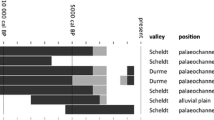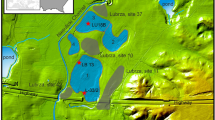Summary
Pollen and macrofossil studies of cores in the raised bog part of a mire in the Vosges revealed an almost complete postglacial record. The major pollen assemblage zones, based upon features of the regional pollen types, have been described and their contacts dated by 14C dating. At 9000 BP a pine forest was replaced by mainlyCorylus, andQuercus plusUlmus migrated into the area.Tilia, Alnus andAcer arrived later. From 7500-5000 BP forests ofCorylus, Quercus, Tilia, Ulmus andAcer prevailed.Abies andFagus are dominant in the vegetation from 5000 BP up to the present time.Carpinus immigrated around 3400 BP. In the present mire vegetation a number of vegetation types have been recognized and mapped. The local fossil assemblages have been compared with the species composition of present day plant communities. It is concluded that the raised bog part of the mire began its existence as a lake, that turned later into an intermediate fen (Caricion canescenti-fuscae). Ombrotrophic bog vegetation is present from 5000 BP on.
Résumé
Le développement de la végétation dans les Hautes Vosges pendant le Post Glaciaire est reconstrué assez complètement par des analyses des pollens et macrofossils dans une section d'une tourbière. Les complexes sporopolliniques régionaux sont décrits et datés par datations carbon-quatorze.
9000 BP: forêt dePinus fut replacée parCorylus. Immigration deQuercus etUlmus, plus tard deTilia, Alnus etAcer.
7500–5000 BP: forêt deCorylus, Quercus, Tilia, Ulmus etAcer. A partir de 5000 BPFagus etAbies sont les principales dominantes dans la région.
3400 BP: Immigration deCarpinus.
La végétation actuelle de la tourbière est analysée et comparue avec les complexes fossils dans la section de la tourbière. Au début du Post Glaciaire il y avait une lac, plus tard une végétation comparable avec leCaricion canescenti-fuscae. A partir de 5000 BP il y a une developpement d'une tourbière bombée.
Similar content being viewed by others
References
Berggren, F. 1969. Atlas of seeds and small fruits of northwest-European plant species. Part 2: Cyperaceae. Swedish Nat. Science Research Council Stockholm.
Beyerinck, W. 1947. Zadenatlas der Nederlandse flora. Wageningen.
Carbiener, R., 1963. Les sols du massif du Hohneck, leurs rapports avec les tapis végétal. In: Le Hohneck, aspects physiques, biologiques et humains. L'association philom. d'Alsace et de Lorraine: 103–153 Strasbourg.
Dresch, J., H. Elhai & M. Denèfle-Labiole. 1966. Analyse pollinique de quatre tourbières du Ballon d'Alsace (Vosges, France). C. R. Soc. Biogéogr. 376: 78–89.
Firbas, F., G. Grünig, J. Weischedel & G. Worzel, 1948. Beiträge zur spät- und nacheiszeitlichen Vegetationsgeschichte der Vogesen. Biblioth. Botanica 121.
Firbas, F. 1949. Spät- und nacheiszeitliche Waldgeschichte Mitteleuropas nördlich der Alpen 1: Allgemeine Waldgeschichte. Gustav Fischer, Jena.
Griffin, K. 1973. Paleoecological aspects of Red Lake Peatland, Beltrami County, Minnesota, Unpubl. Ph. D. Thesis, Univ. of Minnesota. 173 pp.
Guillet, B. 1971. Étude palynologique des podzols 3: La podzolisation sur granite dans les Vosges hercyniennes de l'étage montagnard. Comparaison avec la podzolisation dans les basses Vosges gréseuses et sur le plateau Lorrain. Pollen et Spores 13: 421–446
Hafsten, H. 1969. A proposal for a synchronous sub-division of the late Pleistocene period having global and universal applicability. Nytt Mag. Bot. 16: 1–13.
Hatt, P. 1937. Contribution à l'analyse pollinique des tourbières du nord-est de la France. Bull. Serv. Carte Géol. d'Alsace et de Lorraine 4: 1–79.
Issler, E. 1942. Vegetationskunde der Vogesen. Pflanzensoziologie Bd. 5. Gustav. Fischer Jena.
Iversen, Johs. 1944. Viscum, Hedera and Ilex as climate indicators, a contribution to the study of the postglacial temperature climate. Geol. Fören. Förhandl. 66: 463–483.
Janssen, C. R. & E. L. Janssen-Kettlitz. 1972. A post-atlantic pollen sequence from the tourbière du Tanet (Vosges, France). Pollen Spores 14: 65–77.
Janssen, C. R., A. J. Kalis, G. Tamboer- v. d. Heuvel & E. J. de Valk. 1974. Palynological and paleoecological investigations in the Vosges (France): a research project. Geologie en Mijnbouw 53: 406–414.
Lang, G. 1971. Die Vegetationgeschichte der Wutach Schlucht und Ihrer Umgebung. Die Wutach: 323–349.
Lang, G. 1973. Neue Untersuchungen über die spät- und nacheiszeitliche Vegetationsgeschichte des Schwarzwaldes 4: Das Baldenweger Moor und das einstige Waldbild am Feldberg. Beitr. naturk. Forsch. Südwdtl. 32: 31–51.
Moore, J. J. 1968. A classification of the bogs and the wet heaths of northern Europe. In: Pflanzensoziologische Systematik. Bericht Int. Symp. Stolzenau/Weser 1964: 306–320. Junk, Den Haag.
Oberdorfer, E. 1957. Süddeutsche Pflanzengesellschaften. Pflanzensoziologie Bd. 10. Gustav Fischer Jena.
Philippi, G. 1963. Zur Gliederung der Flachmoorgesellschaften des Südschwarzwaldes und der Hochvogesen. Beitr. naturk. Forsch. Swdtl. 22: 113–135.
Radke, G. J. 1972. Genese der Waldmoore der nördlichen Schwarzwaldes. Ber. Dt. Bot. Ges. 85: 157–164.
Rybnicek, K. & E. Rybnickova. 1968. The history of flora and vegetation on the Bláto mire in southeastern Bohemia, Czechoslovakia (Palaeoecological study). Folia Geobot. Phytotax., 3: 117–142.
Rybnickova, E. & K. Rybnicek, 1971. The determination of local elements in pollen spectra from different sediments. Rev. Palaeobot., Palynol., 11: 165–176.
Teunissen, D. & J. M. C. P. Schoonen. 1973. Vegetations-sedimentationsgeschichtliche Untersuchungen am Grand Etang bei Gerardmer. Eiszeitalter und Gegenwart 23: 63–75.
Westhoff, V. & A. J. den Held. 1969. Plantengemeenschappen van Nederland. Thieme, Zutphen, 324 pp.
Author information
Authors and Affiliations
Additional information
Nomenclature of plant communities and vascular taxa follows Oberdorfer, E., Pflanzensoziologische Excursionsflora f. Süddeutschland und die angrenzenden Gebiete. 2e Aufl., 1962, unless otherwise stated. For nomenclature of moss species see Table 1.
Thanks are extended to Dr. W. G. Mook, Groningen, for dating of various levels of the core and to A. J. Kalis and Mrs. A. A. M. L. Verbeek-Reuvers for providing details on the present upland vegetation. V. Lingen, the Hague, corrected the English text.
Rights and permissions
About this article
Cite this article
Janssen, C.R., Cup-Uiterwijk, M.J.J., Edelman, H.J. et al. Ecologic and paleoecologic studies in the Feigne d'Artimont (Vosges, France). Plant Ecol 30, 165–178 (1975). https://doi.org/10.1007/BF02389705
Accepted:
Issue Date:
DOI: https://doi.org/10.1007/BF02389705




